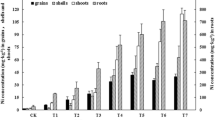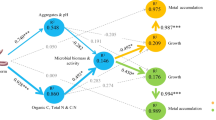Abstract
Nickel (Ni) element is strongly phytotoxic at high concentrations for several plants, but due to its dual behavior and complicated chemistry, it has received little attention in plant nutrition and relevant experimental data are limited. The current research was carried out to study the effect of Ni on maize (Zea mays L.) growth and phytoextraction potential with EDTA assistance, a process termed as chemical assisted phytoremediation. Treatments included two levels of EDTA (0 and 0.5 mM), two levels of Ni (0 and 40 µM) and their combination (EDTA+Ni) that were applied to maize plants grown in a pot experiment. Application of Ni alone or in combination with EDTA reduced maize root and shoot length by 7.8% to 13.3% and by 15.6% to 21.1%, respectively, compared with control, as well as root and shoot dry weight by 42.0% to 60.0% and by 29.8% to 46.6%, respectively. A similar declining trend was observed also for the content of photosynthetic pigments (chl-a, chl-b, total chlorophyll, and carotenoids) as well as total proteins. However, proline, total soluble sugars, and free amino acids showed an increasing trend with application of Ni and EDTA alone or in combination. These treatments significantly decreased P and Na content in maize roots, stems, leaves, and grains, while increased K content compared with control. Application of EDTA with Ni was the most effective treatment to enhance Ni accumulation in maize (50.23 mg per plant) compared with Ni alone (40.62 mg per plant), EDTA alone (27.75 mg per plant), and control (15.51 mg per plant). Application of EDTA in combination with Ni enhanced Ni accumulation by 4.9 folds in maize shoots and by 2.6 folds in roots over control. In conclusion, application of EDTA in suitable concentrations may enhance Ni uptake by maize providing an effective and economic phytoremediation method of Ni-contaminated soils.










Similar content being viewed by others
References
Ahammed GJ, Li X, Yang Y, Liu C, Zhou G, Wan H, Cheng Y (2020a) Tomato WRKY81 acts as a negative regulator for drought tolerance by modulating guard cell H2O2-mediated stomatal closure. Environ Exp Bot 171:103960
Ahammed GJ, Wang Y, Mao Q, Wu M, Yan Y, Ren J, Wang X, Liu A, Chen S (2020b) Dopamine alleviates bisphenol A-induced phytotoxicity by enhancing antioxidant and detoxification potential in cucumber. Environ Pollut 259:113957
Ahammed GJ, Wu M, Wang Y, Yan Y, Mao Q, Ren J, Ma R, Liu A, Chen S (2020c) Melatonin alleviates iron stress by improving iron homeostasis, antioxidant defense and secondary metabolism in cucumber. Sci Hortic 265:109205
Ain Q, Akhtar J, Amjad M, Haq M, Saqib Z (2016) Effect of enhanced nickel levels on wheat plant growth and physiology under salt stress. Commun Soil Sci Plant Anal 47:2538–2546
Ali H, Khan E, Sajad MA (2013) Phytoremediation of heavy metals: concepts and applications. Chemosphere 91:869–881
Amari T, Ghnaya T, Debez A, Taamali M, Youssef NB, Lucchini G (2014) Comparative Ni tolerance and accumulation potentials between Mesembryanthemum crystallinum (halophyte) and Brassica juncea: metal accumulation, nutrient status and photosynthetic activity. J Plant Physiol 171:1634–1644
Anamika S, Eapen S, Fulekar MH (2009) Phytoremediation of cadmium, lead and zinc by Brassica juncea L. Czern Coss J Appl Biosci 13:726–736
Baccouch S, Chaoui A, El Ferjani E (1998) Nickel toxicity: effects on growth and metabolism of maize. J Plant Nutr 21:577–588
Bates L, Waldren R, Teare I (1973) Rapid determination of free proline for water-stress studies. Plant Soil 39:205–207
Ci D, Jiang D, Wollenweber B, Dai T, Jing Q, Cao W (2010) Genetic variance in cadmium tolerance and accumulation in wheat materials differing in ploidy and genome at seedling stage. J Agron Crop Sci 196:302–310
Dan TV, KrishnaRaj S, Saxena PK (2000) Metal tolerance of scented geranium (Pelargonium sp. ‘Frensham’): effects of cadmium and nickel on chlorophyll fluorescence kinetics. Int J Phytoremed 2:91–104
Davis P (1957) A method for the determination of chlorophyll in sea water. Marine CSIRO Aust. Div. Fish. Oceanogr. Rep. No. 7
Gajewska E, Skłodowska M (2009) Nickel-induced changes in nitrogen metabolism in wheat shoots. J Plant Physiol 166:1034–1044
Gajewska E, Skłodowska M, Słaba M, Mazur J (2006) Effect of nickel on antioxidative enzyme activities, proline and chlorophyll contents in wheat shoots. Biol Plant 50:653–659
Ganie SA, Ahammed GJ, Wani SH (2020) Vascular plant one zinc-finger (VOZ) transcription factors: novel regulators of abiotic stress tolerance in rice (Oryza sativa L.). Gen Res Crop Evol 67:799–807
Garbisu C, Alkorta I (2001) Phytoextraction: a cost-effective plant-based technology for the removal of metals from the environment. Biores Technol 77:229–236
Ghasemi F, Heidari R, Jameii R, Purakbar L (2012) Effects of Ni2+ toxicity on Hill reaction and membrane functionality in maize. J Stress Physiol Biochem 8:55–61
Hasan MK, Ahammed GJ, Sun S, Li M, Yin H, Zhou J (2019) Melatonin inhibits cadmium translocation and enhances plant tolerance by regulating sulfur uptake and assimilation in Solanum lycopersicum L. J Agric Food Chem 67:10563–10576
He ZL, Yang XE, Stoffella PJ (2005) Trace elements in agroecosystems and impacts on the environment. J Trace Elem Medic Biol 19:125–140
Kaur L, Gadgil K, Sharma S (2015) Comparative evaluation of salicylic acid and EDTA chelant induced phytoremediation of lead and nickel using Lemna minor L. Trop Plant Res 2:264–270
Kevrešan S, Petrović N, Popović M, Kandrač J (1998) Effect of heavy metals on nitrate and protein metabolism in sugar beet. Biol Plant 41:235–240
Lowry OH, Rosebrough NJ, Farr AL, Randall RJ (1951) Protein measurement with the Folin phenol reagent. J Biol Chem 193:265–275
Maxted A, Black C, West H, Crout N, McGrath S, Young S (2007) Phytoextraction of cadmium and zinc from arable soils amended with sewage sludge using Thlaspi caerulescens: development of a predictive model. Environ Pollut 150:363–372
Negi A, Singh HP, Batish DR, Kohli RK (2014) Ni+2-inhibited radicle growth in germinating wheat seeds involves alterations in sugar metabolism. Acta Physiol Plant 36:923–929
Ouzounidou G, Moustakas M, Symeonidis L, Karataglis S (2006) Response of wheat seedlings to Ni stress: effects of supplemental calcium. Arch Environ Contam Toxic 50:346–352
Page A (1982) Methods of soil analysis: chemical and microbiological properties. American Society of Agronomy, Madison, WI, USA
Pandey N, Sharma CP (2002) Effect of heavy metals Co2+, Ni2+ and Cd2+ on growth and metabolism of cabbage. Plant Sci 163:753–758
Ramarao C, Patil V, Dhak B, Kadrekar S (1983) A simple in vivo method for the determination of nitrite reductase activity in rice roots. Z Pflanzenphysiol 109:81–85
Rew A (2007) Phytoremediation: an environmentally sound technology for pollution prevention, control and remediation in developing countries. Educ Res Rev 2:151–156
Riazi A, Matsuda K, Arslan A (1985) Water-stress induced changes in concentrations of proline and other solutes in growing regions of young barley leaves. J Exp Bot 36:1716–1725
Rinklebe J, Shaheen SM (2017) Redox chemistry of nickel in soils and sediments: a review. Chemosphere 179:265–278
Rus A, Estan M, Gisbert C, Garcia-Sogo B, Serrano R, Caro M (2001) Expressing the yeast HAL1 gene in tomato increases fruit yield and enhances K+/Na+ selectivity under salt stress. Plant Cell Environ 24:875–880
Salt DE, Blaylock M, Kumar NP, Dushenkov V, Ensley BD, Chet I (1995) Phytoremediation: a novel strategy for the removal of toxic metals from the environment using plants. Nat Biotechnol 13:468–474
Sarwar N, Imran M, Shaheen MR, Ishaq W, Kamran A, Matloob A (2017) Phytoremediation strategies for soils contaminated with heavy metals: modifications and future perspectives. Chemosphere 171:710–721
Seregin I, Ivanov V (2001) Physiological aspects of cadmium and lead toxic effects on higher plants. Russ J Plant Physiol 48:523–544
Seth CS (2012) A review on mechanisms of plant tolerance and role of transgenic plants in environmental clean-up. Bot Rev 78:32–62
Shabani N, Sayadi M (2012) Evaluation of heavy metals accumulation by two emergent macrophytes from the polluted soil: an experimental study. Environmentalist 32:91–98
Shafeeq A, Butt ZA, Muhammad S (2012) Response of nickel pollution on physiological and biochemical attributes of wheat (Triticum aestivum L.) var. Bhakar-02. Pak J Bot 44:111–116
Sheoran I, Singal H, Singh R (1990) Effect of cadmium and nickel on photosynthesis and the enzymes of the photosynthetic carbon reduction cycle in pigeonpea (Cajanus cajan L.). Photosynth Res 23:345–351
Sun Y, Zhou Q, Xu Y, Wang L, Liang X (2011) The role of EDTA on cadmium phytoextraction in a cadmium-hyperaccumulator Rorippa globosa. J Environ Chem Ecotox 3:45–51
Sym GJ (1984) Optimisation of the in-vivo assay conditions for nitrate reductase in barley (Hordeum vulgare L. cv. Igri). J Sci Food Agric 35:725–730
Tian Y, Zhang H, Guo W, Chen Z, Wei X, Zhang L, Han L, Dai L (2012) Assessment of the phytoremediation potential of bioenergy crop maize (Zea mays) in soil contaminated by cadmium: Morphology, photosynthesis and accumulation. Fresen Environ Bull 21:3575–3581
Tong Y-P, Kneer R, Zhu Y-G (2004) Vacuolar compartmentalization: a second-generation approach to engineering plants for phytoremediation. Trends Plant Sci 9:7–9
Turgut C, Pepe MK, Cutright TJ (2004) The effect of EDTA and citric acid on phytoremediation of Cd, Cr, and Ni from soil using Helianthus annuus. Environ Pollut 131:147–154
Van Slyke DD, Dillon RT, MacFadyen DA, Hamilton P (1941) Gasometric determination of carboxyl groups in free amino acids. J Biol Chem 141:627–669
Velikova V, Tsonev T, Loreto F, Centritto M (2011) Changes in photosynthesis, mesophyll conductance to CO2, and isoprenoid emissions in Populus nigra plants exposed to excess nickel. Environ Pollut 159:1058–1066
Yusuf M, Fariduddin Q, Hayat S, Ahmad A (2011) Nickel: an overview of uptake, essentiality and toxicity in plants. Bull Environ Contam Toxic 86:1–17
Zhang Y, Liang Y, Zhao X, Jin X, Hou L, Shi Y, Ahammed GJ (2019) Silicon compensates phosphorus deficit-induced growth inhibition by improving photosynthetic capacity, antioxidant potential, and nutrient homeostasis in tomato. Agronomy 9:733
Zhang Z, Wu P, Zhang W, Yang Z, Liu H, Ahammed GJ, Cui J (2020) Calcium is involved in exogenous NO-induced enhancement of photosynthesis in cucumber (Cucumis sativus L.) seedlings under low temperature. Sci Hortic 261:108953
Zhou Y, Guang Y, Li J, Wang F, Ahammed GJ, Yang Y (2019) The CYP74 gene family in watermelon: genome-wide identification and expression profiling under hormonal stress and root-knot nematode infection. Agronomy 9:872
Author information
Authors and Affiliations
Corresponding authors
Ethics declarations
Conflict of interest
Authors declare no conflict of interest.
Additional information
Publisher's Note
Springer Nature remains neutral with regard to jurisdictional claims in published maps and institutional affiliations.
Rights and permissions
About this article
Cite this article
Tipu, M.I., Ashraf, M.Y., Sarwar, N. et al. Growth and Physiology of Maize (Zea mays L.) in a Nickel-Contaminated Soil and Phytoremediation Efficiency Using EDTA. J Plant Growth Regul 40, 774–786 (2021). https://doi.org/10.1007/s00344-020-10132-1
Received:
Accepted:
Published:
Issue Date:
DOI: https://doi.org/10.1007/s00344-020-10132-1




